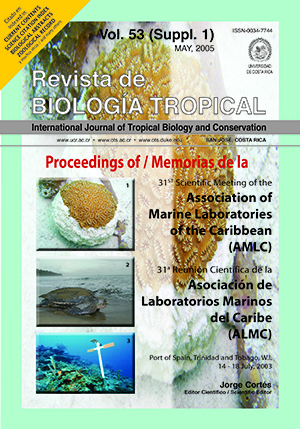Abstract
This project was undertaken as the initial monitoring program to determine if mosquito adulticides applied along the Florida Keys cause adverse ecological effects in the Florida Keys National Marine Sanctuary (FKNMS). The study monitored the distribution and persistence of two mosquito adulticides, permethrin and dibrom (naled), during three separate routine applications by the Florida Keys Mosquito Control District. The approach was to determine if toxic concentrations of the pesticides entered the FKNMS by aerial drift or tidal transport. The amount of pesticide entering the FKNMS by way of aerial drift was monitored by collection on glass fiber filter pads, set on floats in a grid pattern on either side of the FKNMS. Permethrin was recovered from filter pads on the leeward side for each of the three applications, ranging from 0.5 to 50.1 μg/m2 throughout the study. Tidal current transport was monitored by collection of surface and subsurface water samples at each grid site. Tidal transport of naled and dichlorvos (naled degradation product) was apparent in the adjacent waters of the FKNMS. These compounds were detected in subsurface, offshore water at 0.1 to 0.6 μg/l, 14 hr after application. Permethrin was not detected in offshore water samples; however, concentrations ranging from 5.1 to 9.4 μg/l were found in surface water from the canal system adjacent to the application route. Comparison of the observed environmental concentrations with toxicity data (permethrin LC-50, 96 hr for Mysidopsis bahia = 0.02 μg/l) indicated a potential hazard to marine invertebrates in the canals with possible tidal transport to other areas.References
Cox, C. 1998. Insecticide Fact Sheet: Permethrin. J. Pest. Reform. 18: 14-20.
Cox, C. 2002. Insecticide Fact Sheet: Naled (dibrom). J. Pest. Reform. 22: 16-21.
Gargas, M.L., B.L. Finley, D.J. Paustenbauch & T.F. Long. 1999. Environmental health risk assessment: theory and practice, p. 1750-1809. In B. Ballantyne, T.C. Marrs & T. Syversen (eds.). General and Applied Toxicology, 2nd Ed., Groves Dictionaries, Inc., New York, NY.
Hennessey, M.K., H.N. Nigg & D.H. Habeck. 1992. Mosquito (Diptera: Culicidae) adulticide drift into Wildlife Refuges of the Florida Keys. Entomol. Soc. Amer. 14: 714-720.
Johnson, W.W. & M.T. Finley. 1980. Handbook of Acute Toxicity of Chemicals to Fish and Aquatic Invertebrates. Resource Publication 137. U.S. Department of Interior, Fish and Wildlife Service, Washington, DC. Pp. 5-17.
Kidd, H. & D.R. James (eds.). 1991. The Agrochemicals Handbook. 3rd Ed. Royal Society of Chemistry Information Services, Cambridge, UK. Pp. 2-13.
Pierce, R.H. & M.S. Henry. 1988. Pesticide Residues in Mangrove Communities and Cistern Water of the Cayman Islands. Final Report to Cayman Islands Government Mosquito Research and Control Unit, Grand Cayman, C.I., BWI. 76 p.
Pierce, R.H., M.S. Henry, D. Kelly & W. Kozlowski. 2000. Hazard assessment of Temephos applied to a Southwest Florida saltmarsh community. J. Environ. Toxicol. Chem. 19: 501-507.
Schimmel, S.C., R.L. Garnas, J.M. Patrick & J.C. Moore. 1983. Acute toxicity, bioconcentration and persistence of AC 222, 705, Benthiocarb, Chlorpyrifos, Fenvalerate, Methyl Parathion, and Permethrin in the estuarine environment. J. Agri. Food Chem. 31: 104-113.
Edwards, J. 1999. U.S. Office of Prevention, Pesticides and Toxic Substances, EFED’s comments for dichlorvos, pp. 15-16 (www.epa.gov/oppsrrd1/op/ ddvp/efedrisk.pdf)
Peckenpaugh, J., S. Termes & C. Laird. 1997. U.S. EPA, Office of Prevention, Pesticides and Toxic Substances, EFED’s Reregistration Chapter C for naled. Special Review and Reregestration Div. pp. 9-10 (www.epa.gov/pesticides/op/status.htm)
##plugins.facebook.comentarios##

This work is licensed under a Creative Commons Attribution 4.0 International License.
Copyright (c) 2005 Revista de Biología Tropical


